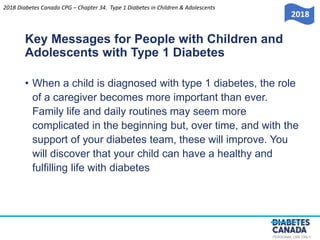1. The document provides recommendations for glycemic targets and insulin therapy for children and adolescents under 18 with type 1 diabetes. It recommends an A1C target of less than 7.5% while minimizing risk of hypoglycemia.
2. For children with persistently poor glycemic control above 10% A1C, the document recommends comprehensive assessment and psychosocial support. Intensive family interventions should also be considered.
3. Rapid-acting insulin analogues in combination with basal insulin is recommended for new onset type 1 diabetes, using a regimen tailored to each child's lifestyle and needs. More intensive management options should be considered if targets are not met.
![PERSONAL USE ONLY
Recommendation 4
Glycemic Targets
4. Children and adolescents <18 years of age should aim
for an A1C target <7.5% [Grade D, Consensus]
• Attempts should be made to safely reach the recommended
glycemic target, while minimizing the risk for severe or
recurrent hypoglycemia. Treatment targets should be tailored
to each child, taking into consideration individual risk factors for
hypoglycemia [Grade D, Consensus]
• In children <6 years of age, particular care to minimize
hypoglycemia is recommended because of the potential
association in this age group between severe hypoglycemia
and later cognitive impairment [Grade D, Level 4]
2018
2018 Diabetes Canada CPG – Chapter 34. Type 1 Diabetes in Children & Adolescents](https://image.slidesharecdn.com/ch34type1children-230309031037-0aa2b810/85/ch34_type1_children-pptx-1-320.jpg)

![PERSONAL USE ONLY
Recommendation 5
Glycemic Targets
5. Children with persistently poor glycemic control
(e.g., A1C >10.0%) should be assessed with a
validated tool by a specialized pediatric DHC
team for comprehensive interdisciplinary assessment
and referred for psychosocial support as indicated
[Grade D, Consensus]. Intensive family and
individualized psychological interventions aimed
at improving glycemic control should be considered
to improve chronically poor metabolic control [Grade A,
Level 1A]
2018 Diabetes Canada CPG – Chapter 34. Type 1 Diabetes in Children & Adolescents
DHC, diabetes health-care](https://image.slidesharecdn.com/ch34type1children-230309031037-0aa2b810/85/ch34_type1_children-pptx-3-320.jpg)

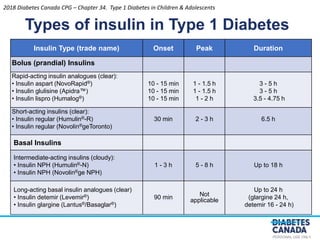


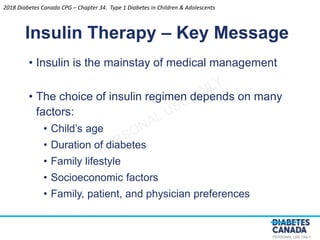


![PERSONAL USE ONLY
Recommendation 6
Insulin Therapy
6. Children with new-onset diabetes should be started
on boluses of rapid-acting insulin analogues
combined with basal insulin (e.g. intermediate-acting
insulin or long-acting basal insulin analogue) using
an individualized regimen that best addresses the
practical issues of daily life [Grade D, Consensus]
2018 Diabetes Canada CPG – Chapter 34. Type 1 Diabetes in Children & Adolescents](https://image.slidesharecdn.com/ch34type1children-230309031037-0aa2b810/85/ch34_type1_children-pptx-11-320.jpg)
![PERSONAL USE ONLY
Recommendation 7
Insulin Therapy
7. Insulin therapy should be assessed at each clinical encounter to
ensure it still enables the child to meet A1C targets, minimizes the risk
of hypoglycemia and allows flexibility in carbohydrate intake, daily
schedule and activities [Grade D, Consensus]. If these goals are not being
met, an intensified diabetes management approach (including
increased education, monitoring and contact with diabetes team)
should be used [Grade A, Level 1 for adolescents; Grade D, Consensus for younger
children], and treatment options may include the following:
• Increased frequency of injections [Grade D, Consensus]
• Change in the type of basal and/or bolus insulin [Grade B, Level 2,
for adolescents; Grade D, Consensus, for younger children]
• Change to CSII therapy [Grade C, Level 3]
2018 Diabetes Canada CPG – Chapter 34. Type 1 Diabetes in Children & Adolescents
CSII, continuous subcutaneous insulin infusion](https://image.slidesharecdn.com/ch34type1children-230309031037-0aa2b810/85/ch34_type1_children-pptx-12-320.jpg)








![PERSONAL USE ONLY
Recommendation 8
Treatment of Hypoglycemia
8. In children, the use of mini-doses of glucagon (10
mcg per year of age with minimum dose 20 mcg and
maximum dose 150 mcg) should be considered in
the home management of mild or impending
hypoglycemia associated with inability or refusal to
take oral carbohydrate [Grade D, Level 4]
2018 Diabetes Canada CPG – Chapter 34. Type 1 Diabetes in Children & Adolescents](https://image.slidesharecdn.com/ch34type1children-230309031037-0aa2b810/85/ch34_type1_children-pptx-21-320.jpg)
![PERSONAL USE ONLY
Recommendation 9
Treatment of Hypoglycemia
9. In the home situation, severe hypoglycemia in an
unconscious child >5 years of age should be
treated with 1 mg glucagon subcutaneously or
intramuscularly. In children <5 years of age, a dose
of 0.5 mg glucagon should be given. The episode
should be discussed with the DHC team as soon as
possible and consideration given to reducing insulin
doses for the next 24 hours to prevent further severe
hypoglycemia [Grade D, Consensus]
2018 Diabetes Canada CPG – Chapter 34. Type 1 Diabetes in Children & Adolescents
DHC, diabetes health-care](https://image.slidesharecdn.com/ch34type1children-230309031037-0aa2b810/85/ch34_type1_children-pptx-22-320.jpg)
![PERSONAL USE ONLY
Recommendation 10
Treatment of Hypoglycemia
10. Dextrose 0.5 to 1 g/kg should be given
intravenously over 1-3 minutes to treat severe
hypoglycemia with unconsciousness when
intravenous access is available [Grade D, Consensus]
2018 Diabetes Canada CPG – Chapter 34. Type 1 Diabetes in Children & Adolescents](https://image.slidesharecdn.com/ch34type1children-230309031037-0aa2b810/85/ch34_type1_children-pptx-23-320.jpg)
![PERSONAL USE ONLY
Recommendation 11
Physical Activity
11. Regular physical activity ≥3 times per week for
≥60 minutes each time should be encouraged for all
children with diabetes [Grade A, Level 1]
2018 Diabetes Canada CPG – Chapter 34. Type 1 Diabetes in Children & Adolescents
2018](https://image.slidesharecdn.com/ch34type1children-230309031037-0aa2b810/85/ch34_type1_children-pptx-24-320.jpg)






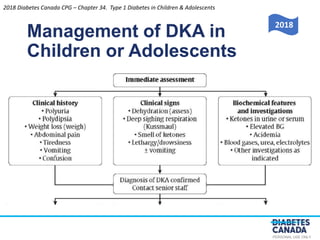


![PERSONAL USE ONLY
Recommendation 12
Diabetic Ketoacidosis
12. To prevent DKA in children with diabetes:
• Targeted public awareness campaigns should be
considered to educate parents, other caregivers (e.g.,
teachers), and healthcare providers about the early
symptoms of diabetes [Grade C, Level 3]
• Immediate assessment of ketone and acid-base status
should be done in any child presenting with new onset
diabetes [Grade D, Consensus]
• Comprehensive education and support services [Grade C,
Level 3], as well as 24-hour telephone services [Grade C, Level
3], should be available for families of children with diabetes
2018 Diabetes Canada CPG – Chapter 34. Type 1 Diabetes in Children & Adolescents
DKA, diabetic ketoacidosis](https://image.slidesharecdn.com/ch34type1children-230309031037-0aa2b810/85/ch34_type1_children-pptx-34-320.jpg)
![PERSONAL USE ONLY
Recommendation 13
Diabetic Ketoacidosis
13. DKA in children should be treated according to
pediatric-specific protocols [Grade D, Consensus]. If
appropriate expertise/facilities are not available
locally, there should be immediate consultation
with a centre with expertise in pediatric diabetes
[Grade D, Consensus]
2018 Diabetes Canada CPG – Chapter 34. Type 1 Diabetes in Children & Adolescents
DKA, diabetic ketoacidosis](https://image.slidesharecdn.com/ch34type1children-230309031037-0aa2b810/85/ch34_type1_children-pptx-35-320.jpg)
![PERSONAL USE ONLY
Recommendation 14
Diabetic Ketoacidosis
14. In children in DKA, rapid administration of
hypotonic fluids should be avoided [Grade D, Level
4]. Circulatory compromise should be treated with
only enough isotonic fluids to correct circulatory
inadequacy [Grade D, Consensus]. Replacement of
fluid deficit should be extended over a 48-hour
period with regular reassessments of fluid status
[Grade D, Level 4]
2018 Diabetes Canada CPG – Chapter 34. Type 1 Diabetes in Children & Adolescents
DKA, diabetic ketoacidosis](https://image.slidesharecdn.com/ch34type1children-230309031037-0aa2b810/85/ch34_type1_children-pptx-36-320.jpg)
![PERSONAL USE ONLY
Recommendation 15
Diabetic Ketoacidosis
15. In children in DKA, an intravenous insulin bolus
should not be given [Grade D, Consensus]. The insulin
infusion should not be started for at least 1 hour
after starting fluid replacement therapy [Grade D,
Level 4]. An intravenous infusion of short-acting insulin
should be used at an initial dose of 0.05 to 0.1
units/kg/h, depending on the clinical situation [Grade
A, Level 1A]
2018 Diabetes Canada CPG – Chapter 34. Type 1 Diabetes in Children & Adolescents
DKA, diabetic ketoacidosis](https://image.slidesharecdn.com/ch34type1children-230309031037-0aa2b810/85/ch34_type1_children-pptx-37-320.jpg)
![PERSONAL USE ONLY
Recommendation 16
Diabetic Ketoacidosis
16. In children in DKA, once blood glucose reaches
≤17.0 mmol/L, intravenous dextrose should be
started to prevent hypoglycemia. The dextrose
infusion should be increased, rather than reducing
insulin, to prevent rapid decreases in glucose. The
insulin infusion should be maintained until pH
normalizes and ketones have mostly cleared [Grade D,
Consensus]
2018 Diabetes Canada CPG – Chapter 34. Type 1 Diabetes in Children & Adolescents
2018
DKA, diabetic ketoacidosis](https://image.slidesharecdn.com/ch34type1children-230309031037-0aa2b810/85/ch34_type1_children-pptx-38-320.jpg)
![PERSONAL USE ONLY
Recommendation 17-18
Diabetic Ketoacidosis
17. In children in DKA, administration of sodium
bicarbonate should be avoided except in extreme
circulatory compromise, as this may contribute to
cerebral edema [Grade D, Level 4]
18. In children in DKA, either mannitol or hypertonic
saline may be used in the treatment of cerebral
edema [Grade D, Level 4]
2018 Diabetes Canada CPG – Chapter 34. Type 1 Diabetes in Children & Adolescents
2018
DKA, diabetic ketoacidosis](https://image.slidesharecdn.com/ch34type1children-230309031037-0aa2b810/85/ch34_type1_children-pptx-39-320.jpg)








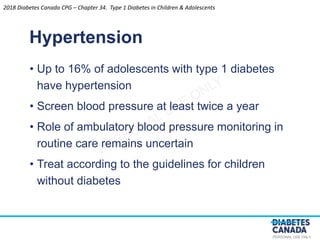

![PERSONAL USE ONLY
Recommendation 19
Microvascular Complications
19. Children ≥12 years with diabetes duration > 5 years should be
screened annually for CKD with a first morning urine ACR
(preferred) [Grade B, Level 2] or a random ACR [Grade D,
Consensus]. Abnormal results should be confirmed [Grade B, Level
2] at least 1 month later with a first morning ACR and, if
abnormal, followed by timed, overnight or 24-hour split urine
collections for albumin excretion rate [Grade D, Consensus].
Albuminuria (ACR >2.5 mg/mmol; AER >20 mcg/min) should
not be diagnosed unless it is persistent, as demonstrated by 2
consecutive first morning ACR or timed collections obtained at
3- to 4-month intervals over a 6- to 12-month period [Grade D,
Consensus]
2018 Diabetes Canada CPG – Chapter 34. Type 1 Diabetes in Children & Adolescents
ACR, albumin to creatinine ratio; AER, albumin excretion rate; CKD, chronic kidney disease](https://image.slidesharecdn.com/ch34type1children-230309031037-0aa2b810/85/ch34_type1_children-pptx-50-320.jpg)
![PERSONAL USE ONLY
Recommendation 20
Microvascular Complications
20. Children ≥12 years with persistent albuminuria
should be treated per adult guidelines (see Chronic
Kidney Disease in Diabetes chapter) [Grade D, Consensus]
2018 Diabetes Canada CPG – Chapter 34. Type 1 Diabetes in Children & Adolescents](https://image.slidesharecdn.com/ch34type1children-230309031037-0aa2b810/85/ch34_type1_children-pptx-51-320.jpg)
![PERSONAL USE ONLY
Recommendation 21
Microvascular Complications
21. Children ≥15 years with 5 years diabetes duration
should be annually screened and evaluated for
retinopathy by an expert professional [Grade C, Level
3]. The screening interval can be increased to every
2 years in children with type 1 diabetes who have
good glycemic control, duration of diabetes <10
years and no significant retinopathy (as
determined by an expert professional) [Grade D,
Consensus]
2018 Diabetes Canada CPG – Chapter 34. Type 1 Diabetes in Children & Adolescents](https://image.slidesharecdn.com/ch34type1children-230309031037-0aa2b810/85/ch34_type1_children-pptx-52-320.jpg)
![PERSONAL USE ONLY
Recommendation 22
Microvascular Complications
22. Children ≥15 years with 5 years duration and poor
metabolic control should be questioned about
symptoms of numbness, pain, cramps and
paresthesia, and examined for skin sensation,
vibration sense, light touch and ankle reflexes
[Grade D, Consensus]
2018 Diabetes Canada CPG – Chapter 34. Type 1 Diabetes in Children & Adolescents](https://image.slidesharecdn.com/ch34type1children-230309031037-0aa2b810/85/ch34_type1_children-pptx-53-320.jpg)
![PERSONAL USE ONLY
Recommendation 25
Comorbid Conditions and Other Complications
25. Children with type 1 diabetes who are <12 years of
age should be screened for dyslipidemia if they
have other risk factors, such as obesity (body mass
index >97th percentile for age and gender) and/or a
family history of dyslipidemia or premature CVD.
Routine screening for dyslipidemia should begin at
12 years of age, with repeat screening after 5 years
[Grade D, Consensus]
2018 Diabetes Canada CPG – Chapter 34. Type 1 Diabetes in Children & Adolescents
CVD, cardiovascular disease](https://image.slidesharecdn.com/ch34type1children-230309031037-0aa2b810/85/ch34_type1_children-pptx-54-320.jpg)
![PERSONAL USE ONLY
Recommendation 26
Comorbid Conditions and Other Complications
26. Once dyslipidemia is diagnosed in children with type
1 diabetes, the dyslipidemia should be monitored
regularly and efforts should be made to improve
metabolic control and promote healthy behaviours.
While it can be treated effectively with statins, a
specific cut-off to initiate treatment is yet to be
determined in this age category [Grade D, Consensus]
2018 Diabetes Canada CPG – Chapter 34. Type 1 Diabetes in Children & Adolescents](https://image.slidesharecdn.com/ch34type1children-230309031037-0aa2b810/85/ch34_type1_children-pptx-55-320.jpg)
![PERSONAL USE ONLY
Recommendations 27-28
Comorbid Conditions and Other Complications
27. All children with type 1 diabetes should be screened
for hypertension at least twice annually [Grade D,
Consensus]
28. Children with type 1 diabetes and BP readings
persistently above the 95th percentile for age
should receive healthy behaviour counselling,
including weight loss if overweight [Grade D, Level 4]. If
BP remains elevated, treatment should be initiated
based on recommendations for children without
diabetes [Grade D, Consensus]
2018 Diabetes Canada CPG – Chapter 34. Type 1 Diabetes in Children & Adolescents
BP, blood pressure](https://image.slidesharecdn.com/ch34type1children-230309031037-0aa2b810/85/ch34_type1_children-pptx-56-320.jpg)


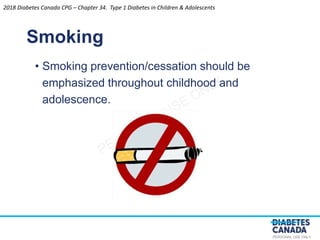

![PERSONAL USE ONLY
Recommendations 29
Comorbid Conditions and Other Complications
29. Influenza vaccination should be offered to children
with diabetes as a way to prevent an intercurrent
illness that could complicate diabetes management
[Grade D, Consensus]
2018 Diabetes Canada CPG – Chapter 34. Type 1 Diabetes in Children & Adolescents](https://image.slidesharecdn.com/ch34type1children-230309031037-0aa2b810/85/ch34_type1_children-pptx-61-320.jpg)
![PERSONAL USE ONLY
Recommendations 30-31
Comorbid Conditions and Other Complications
30. Formal smoking prevention and cessation
counseling should be part of diabetes management
for children with diabetes [Grade D, Consensus]
31. Adolescents should be regularly counseled around
alcohol and substance use [Grade D, Consensus]
2018 Diabetes Canada CPG – Chapter 34. Type 1 Diabetes in Children & Adolescents](https://image.slidesharecdn.com/ch34type1children-230309031037-0aa2b810/85/ch34_type1_children-pptx-62-320.jpg)
![PERSONAL USE ONLY
Recommendation 32
Comorbid Conditions and Other Complications
32. Adolescent females with type 1 diabetes should
receive counseling on contraception and sexual
health in order to prevent unplanned pregnancy
[Grade D, Level 4]
2018 Diabetes Canada CPG – Chapter 34. Type 1 Diabetes in Children & Adolescents](https://image.slidesharecdn.com/ch34type1children-230309031037-0aa2b810/85/ch34_type1_children-pptx-63-320.jpg)





![PERSONAL USE ONLY
Recommendation 23
Comorbid Conditions and Other Complications
23. Children and adolescents with diabetes, along with
their families, should be screened regularly for
psychosocial or psychological disorders [Grade D,
Consensus] and should be referred to an expert in
mental health and/or psychosocial issues for
intervention when required [Grade D, Consensus]
2018 Diabetes Canada CPG – Chapter 34. Type 1 Diabetes in Children & Adolescents](https://image.slidesharecdn.com/ch34type1children-230309031037-0aa2b810/85/ch34_type1_children-pptx-69-320.jpg)
![PERSONAL USE ONLY
Recommendation 24
Comorbid Conditions and Other Complications
24. Adolescents with type 1 diabetes should be regularly
screened using nonjudgmental questions about
weight and body image concerns, dieting, binge
eating and insulin omission for weight loss [Grade D,
Consensus]
2018 Diabetes Canada CPG – Chapter 34. Type 1 Diabetes in Children & Adolescents](https://image.slidesharecdn.com/ch34type1children-230309031037-0aa2b810/85/ch34_type1_children-pptx-70-320.jpg)
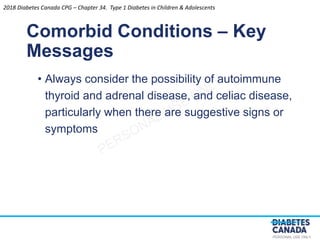
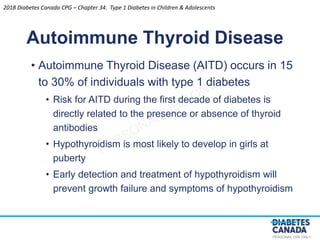
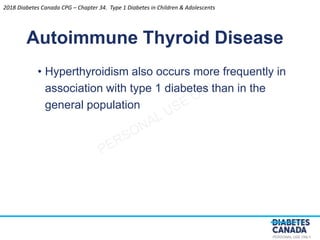
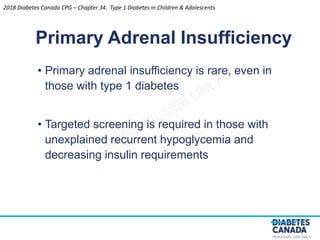

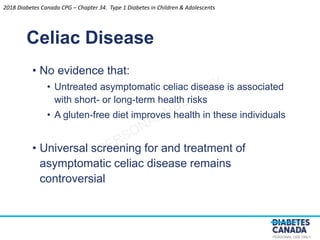

![PERSONAL USE ONLY
Recommendation 33
Comorbid Conditions and Other Complications
33. Children with type 1 diabetes who have anti-thyroid
antibodies should be considered high risk for
autoimmune thyroid disease [Grade C, Level 3].
Children with type 1 diabetes should be screened at
diabetes diagnosis with repeat screening every 2
years using a serum thyroid- stimulating hormone
and thyroid peroxidase antibodies [Grade D,
Consensus]. More frequent screening is indicated in
the presence of positive anti-thyroid antibodies,
thyroid symptoms or goiter [Grade D, Consensus]
2018 Diabetes Canada CPG – Chapter 34. Type 1 Diabetes in Children & Adolescents](https://image.slidesharecdn.com/ch34type1children-230309031037-0aa2b810/85/ch34_type1_children-pptx-78-320.jpg)
![PERSONAL USE ONLY
Recommendation 34
Comorbid Conditions and Other Complications
34. Children with type 1 diabetes and symptoms of
classic or atypical celiac disease should undergo
celiac screening [Grade D, Consensus] and, if
confirmed, be treated with a gluten-free diet to
improve symptoms [Grade D, Level 4] and prevent the
long-term sequelae of untreated classic celiac
disease [Grade D, Level 4]. Discussion of the pros and
cons of screening and treatment of asymptomatic
celiac disease should take place with children and
adolescents with type 1 diabetes and their families
[Grade D, Consensus]
2018 Diabetes Canada CPG – Chapter 34. Type 1 Diabetes in Children & Adolescents](https://image.slidesharecdn.com/ch34type1children-230309031037-0aa2b810/85/ch34_type1_children-pptx-79-320.jpg)


